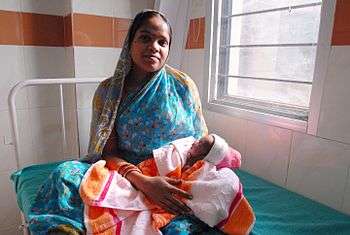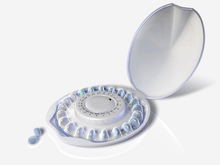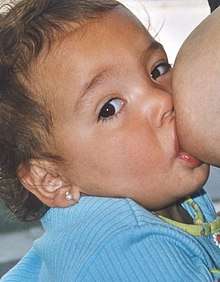Birth spacing

Birth spacing, pregnancy spacing, or inter-pregnancy interval refers to how soon after a prior pregnancy a woman becomes pregnant or gives birth again. There are health risks associated both with pregnancies placed closely together and those placed far apart, but the majority of health risks are associated with births that occur too close together.[1] The March of Dimes recommends a minimum of 18 months before becoming pregnant again following an uncomplicated vaginal delivery of a full term infant;[2] the WHO recommends 24 months.[3] A shorter interval may be appropriate if the pregnancy ended in abortion or miscarriage, typically 6 months.[2][3] If the mother has had a prior C-section, it is advisable to wait before giving birth again due to the risk of uterine rupture in the mother during childbirth, with recommendations of a minimum inter-delivery interval ranging from a year to three years. Pregnancy intervals longer than 5 years are associated with an increased risk of pre-eclampsia.[4] The global public heath burden of short inter-pregnancy intervals is substantial.[3] Family planning can help increase inter-pregnancy interval.[5]
Factors influencing birth spacing


Family planning, such as the use of contraceptives can increase inter-pregnancy interval.[5] Breastfeeding and extended breastfeeding can also increase birth spacing due to lactational amenorrhea.[6][7][8][9]
Cultural and religious attitudes towards both sex and the use of contraceptives,[10] price and availability of health care, and poverty are all factors which can decrease inter-pregnancy intervals.[11]
Health risks
Short inter-pregnancy interval
Short inter-pregnancy interval is associated with an increase in maternal mortality,[5][12] stillbirth, and child mortality.[13] Inter-pregnancy interval of lower than 18 months is associated with an increased risk of pre-term birth.[2]
Short inter-pregnancy interval after a prior C-section can be a contraindication for having a vaginal birth after a prior C-section (VBAC). In one study inter-pregnancy intervals shorter than 6 months were associated with 2-3 times increased risk of uterine rupture, major morbidity, and blood transfusion during vaginal delivery in mothers with at least one prior C-section.[14]
Complications of a short inter-pregnancy interval are lower after an abortion or miscarriage compared to a full-term pregnancy.[13]
Long inter-pregnancy interval
A inter-pregnancy interval of greater than 5 years is associated in an increased risk of pre-eclampsia.[4][12]
Public Health
The global public heath burden of short inter-pregnancy intervals is substantial.[3] In developing countries, children born two years or early after an older sibling were at a 60% increased risk of death in infancy, while those born between two to three years had a 10% increase, compared with those born after intervals of four to five years.[15] Various organisations, including the World Health Organization[3] and the Bill and Melinda Gates Foundation[11] have identified birth spacing as an important area of public health intervention.
References
- ↑ Shachar BZ, Lyell DJ. "Interpregnancy interval and obstetrical complications". www.uptodate.com. Retrieved 2018-04-22.
- 1 2 3 "How long should you wait before getting pregnant again?". The March of Dimes. Retrieved 2018-04-03.
- 1 2 3 4 5 Report of a technical consultation on birth spacing (PDF) (Report). WHO. 2005. Archived from the original (PDF) on February 2017. Retrieved 2018-04-03.
- 1 2 Conde-Agudelo A, Rosas-Bermúdez A, Kafury-Goeta AC (April 2007). "Effects of birth spacing on maternal health: a systematic review". American Journal of Obstetrics and Gynecology. 196 (4): 297–308. doi:10.1016/j.ajog.2006.05.055. PMID 17403398.
- 1 2 3 Ganatra B, Faundes A (October 2016). "Role of birth spacing, family planning services, safe abortion services and post-abortion care in reducing maternal mortality". Best Practice & Research. Clinical Obstetrics & Gynaecology. 36: 145–155. doi:10.1016/j.bpobgyn.2016.07.008. PMID 27640082.
- ↑ Tommaselli, Giovanni A; Guida, Maurizio; Palomba, Stefano; Barbato, Michele; Nappi, Carmine (April 2000). "Using complete breastfeeding and lactational amenorrhoea as birth spacing methods". Contraception. 61 (4): 253–257. doi:10.1016/S0010-7824(00)00101-3. ISSN 0010-7824.
- ↑ Kennedy KI, Rivera R, McNeilly AS (May 1989). "Consensus statement on the use of breastfeeding as a family planning method". Contraception. 39 (5): 477–96. doi:10.1016/0010-7824(89)90103-0. PMID 2656086.
- ↑ P, Caldwell; JC, Caldwell (1981). "The function of child-spacing in traditional societies and the direction of change".
- ↑ Konner, M.; Worthman, C. (1980-02-15). "Nursing frequency, gonadal function, and birth spacing among !Kung hunter-gatherers". Science. 207 (4432): 788–791. doi:10.1126/science.7352291. ISSN 0036-8075. PMID 7352291.
- ↑ Bavel, Jan Van; Kok, Jan (2004-06-01). "Birth Spacing in the Netherlands. The Effects of Family Composition, Occupation and Religion on Birth Intervals, 1820–1885". European Journal of Population / Revue européenne de Démographie. 20 (2): 119–140. doi:10.1023/B:EUJP.0000033860.39537.e2. ISSN 0168-6577.
- 1 2 Gates B, Gates M. "Warren Buffett's Best Investment". gatesnotes.com. Retrieved 2018-04-22.
- 1 2 Conde-Agudelo, Agustin; Belizán, José M. (2000-11-18). "Maternal morbidity and mortality associated with interpregnancy interval: cross sectional study". BMJ. 321 (7271): 1255–1259. doi:10.1136/bmj.321.7271.1255. ISSN 0959-8138. PMID 11082085.
- 1 2 Fotso JC, Cleland J, Mberu B, Mutua M, Elungata P (November 2013). "Birth spacing and child mortality: an analysis of prospective data from the Nairobi urban health and demographic surveillance system". Journal of Biosocial Science. 45 (6): 779–98. doi:10.1017/S0021932012000570. PMC 3785173. PMID 22958417.
- ↑ Stamilio DM, DeFranco E, Paré E, Odibo AO, Peipert JF, Allsworth JE, Stevens E, Macones GA (November 2007). "Short interpregnancy interval: risk of uterine rupture and complications of vaginal birth after cesarean delivery". Obstetrics and Gynecology. 110 (5): 1075–82. doi:10.1097/01.AOG.0000286759.49895.46. PMID 17978122.
- ↑ Rutstein SO (April 2005). "Effects of preceding birth intervals on neonatal, infant and under-five years mortality and nutritional status in developing countries: evidence from the demographic and health surveys". International Journal of Gynaecology and Obstetrics. 89 Suppl 1: S7–24. doi:10.1016/j.ijgo.2004.11.012. PMID 15820369.